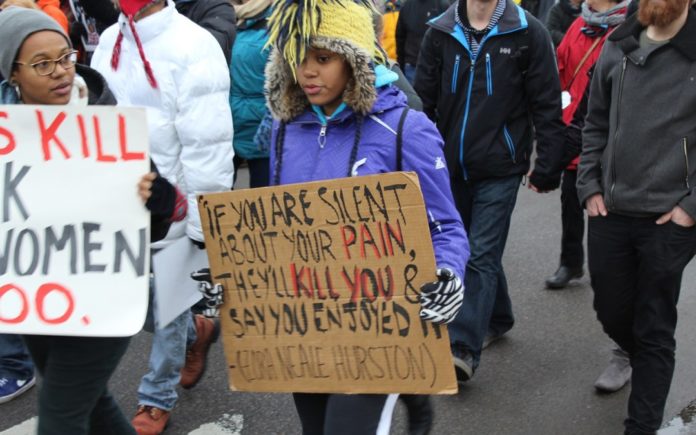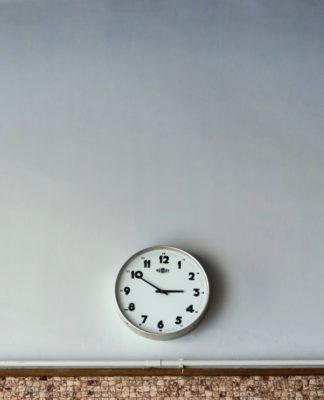
What was interesting to hear, throughout the discussion that we began in part one, was how many people (men and women both) link the prevalence of street harassment to gender inequality elsewhere in society, specifically the workplace.
In Minnesota, there is a program in place that requires all public sector jobs to assess and adjust the pay scales every three years. But a change in legislation that would make private companies with whom they do business do the same assessments was voted down in 2014. And, certainly, it’s about more than just the wage gap, which is still listed as 78 cents on the dollar across the country, as the numbers don’t always tell the whole story anyway.
Gender beyond the street
Brian, who works in downtown St. Paul, acknowledges this disparity: “It’s different for women at work. How they’re dressed, or the way they carry themselves. And sense of humor. What a women thinks is funny can make a huge difference.”
“We have to conform,” Jo says.
Brian uses instead the word “adapt.”
“It’s an uphill battle. From the street to the workplace.” Kimberly says. “Women even have to ask for a raise in a different way than men.”
(If you’d like to read further, there’s an excellent MPR piece on that specific issue)
But is that the larger issue?
“Call it ‘Trickle-Down Gendernomics,’” Jo says with a laugh (and a groan from everyone else). “It starts with a lack of respect and power at the top, and by the time it gets down to the street it’s catcalling.”
“Too much of our collective consciousness about women in the workplace is still stuck in the 1950’s,” Max, a St. Paul schoolteacher, says.
And then there are the numbers. So many numbers. Percentages and stats and fractions that tell us to be optimistic or pessimistic, depending on how you look at the data:
Women make up more than half of the professional and technical workforce, and, according to a recent study by the Pew Research Center, women entering the workforce are more educated than men (that article can be found here: 10 Findings About Women In the Workplace ). More women are attending, and graduating college. No longer are women defined simply as the housewives, the caregivers, the child-raisers. In fact, women as primary breadwinners now make up 40% of the workplace, compared to only 11% in 1960.
The rise of the female heroine
So now what? When it comes down to it, will the rise of women in the workplace, even when things become “equal” make things safer for women on the street?
If we make the connection between workplace inequality and street harassment, we have to acknowledge the fact that it doesn’t matter how successful a woman is at work when she is catcalled or subjected to harassment outdoors.
As Jenny, a single mother in St. Paul, says, “…catcalling has a lot to do with men wanting to feel dominant over a woman. It doesn’t matter what the relationship is between men and women in the workplace, the street is a different environment, one of anonymity and fewer consequences. No one is getting fired from their job by catcalling to a woman on the street. And most catcalling on the street is shutdown if the woman being called to does something unexpected to startle the man/men calling to her.”
Maybe how about the way society views women from a popular culture standpoint? Could that be a key to starting the discussion on equality?
This was brought up by Mai, 20, a student in Minneapolis. She suggests that we have to start with youth in order to see a cultural shift, i.e. it’s already too late by the time women enter the workforce.
“It’s what we’re taught as children that stays with us,” she says.
Strong women aren’t a new thing in literature, as we can go all the way back to Chaucer’s Canterbury Tales to find the independent-minded Wife of Bath. Joan of Arc is another great example, all the way up to Jane Eyre.
But what we have also seen recently is a redefinition of the roles these female characters can play (and the limits thereof). Long dominated by boys/men, action roles have now seen a rise in female protagonists taking charge in books, to international acclaim and record sales’.
“We have seen an epic rise of ‘phenomenon novels’ which have been some of the biggest books featuring a strong, smart, female protagonist,” Mai says.
And, with an even greater impact, these books are turned into blockbuster films that are dominating box offices across the world.
Could this have an impact on respecting women in the street?
Like Hermione Granger from Harry Potter, who was often the most capable of the three main characters (certainly the most intelligent), and often proved herself to be the most vital member of the group.
(Check out a hilarious BuzzFeed post about that here)
The Girl with the Dragon Tattoo took on the issue of rape specifically, and put the spotlight on a complicated hero that was bent on revenge in an almost noir-like manner. Lisbeth Salander was no femme fatale, but rather the hero (or maybe anti-hero?) that achieved her goals by whatever means necessary.
The Divergent series saw a character that was special, the most special, more so than her male counterparts, and it should also be noted that many of those in power in that series (both good and bad) were also women.
And perhaps the most prominent is The Hunger Games which brought to life Katniss Everdeen (cheesy name notwithstanding) as a sharpshooting, no-nonsense crusader for the common man and woman. Jennifer Lawrence has since become an idol to millions for playing her in the film adaptations.
And these women are mostly clothed (something that is often missing from the classic female superheroes of comic lore) relying on skills and smarts instead of sexuality to get things done.
The impact of these novels and films on our culture is indelible. These are the type of women that kids are now growing up with, and they have resonated beyond American youth culture; these books (and subsequent movies) have made an impact with all age groups from all walks of life.
What kind of impact will this have, then, on the coming generation’s view of women? Will catcalling diminish when the coming generations think first and foremost of that woman walking down the street as a skilled archer, as a bad-ass crime fighter, or as the most powerfully divergent?
Maybe that means something for the future?
“But who knows,” Mai says, “Black Widow [of The Avengers] still can’t get her own movie or action figure. And don’t get me started on video games.”
And, as Jenny offers, “I think the discussion must go much deeper if its to ever reach some kind of conclusion. There have always been strong women in western literature, and there has always been the desire of men to dominate and control strong women, or to make sure that women stay contained in the role that society demands of them.”
Clearly, simply giving strong role models to girls perhaps does not go far enough. And neither does equality in the workplace. While these are factors that certainly lend in the fight toward permanent change, it is ultimately a systemic issue that cannot be changed by superficial notions of “power.”
Read this next: Minnesota ranked #1 best state for women
















